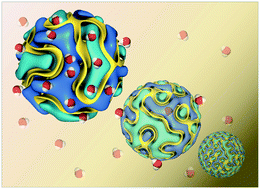Molecular engineering of super-swollen inverse bicontinuous cubic and sponge lipid phases for biomedical applications
Abstract
The remarkable range of lyotropic liquid crystalline mesophases formed by lipid self-assembly in aqueous conditions has generated significant research interest, particularly due to their potential applications in drug delivery, in meso crystallisation, imaging, biocatalysis, and enzymatic reaction control. Among these mesophases, the inverse bicontinuous cubic mesophase, in particular, exhibits an intriguing structure with a continuous tortuous lipid membrane subdividing three-dimensional space into two interpenetrating water channels. The sponge phase is often called the melted cubic phase, as its structure is also characterised by the existence of two water channels separated by a continuous lipid bilayer but the surface is random and sponge-like. Distinct lipid membrane and aqueous regions within the lipidic cubic and sponge structure can be exploited to encapsulate hydrophobic and hydrophilic entities, respectively. A key advantage is that the cubic or the sponge structure can be fine-tuned via compositional or environmental mechanisms towards the control of diffusion and release rates for cargo molecules, as well as crystal growth during in meso crystallisation. However, a major drawback of most conventional laboratory synthesised lipidic cubic and sponge structures is the small size of the aqueous channels (typical dimensions of 3–5 nm) which limits the accommodation of large biomolecules such as soluble globular proteins, membrane proteins with large extracellular domains, and nucleic acids. Over the past two decades, interest has grown in designing super-swollen water channels that considerably exceed the normal dimension within lipidic cubic or sponge mesophases. Several swelling mechanisms have been developed, including those based on electrostatic swelling, headgroup hydration, and the variation of external conditions. To date, the water channels of some lipidic cubic and sponge mesophases have been increased to over 40 nm in diameter rendering such materials capable of encapsulating much larger biomolecules than had previously been achieved (e.g. β-galactosidase with a measured hydrodynamic radius of 11.8 nm). In this mini-review article, we summarise the current literature on highly swollen lipidic cubic and sponge mesophases, discuss the molecular system approaches used to achieve swelling, present first order design principles for guidance, and provide application examples in drug delivery and in meso protein crystallisation.



 Please wait while we load your content...
Please wait while we load your content...